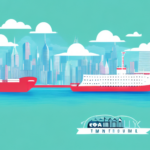A Comprehensive Guide to FTL Shipping
If you're looking for a reliable and efficient way to transport large shipments, FTL (Full Truckload) shipping may be the option for you. In this guide, we'll explore all aspects of FTL shipping, from its definition to optimal usage scenarios, and everything in between. Let's get started.
What is FTL Shipping?
FTL shipping is a mode of transportation that involves filling an entire truck with a single shipment. It's an ideal option for businesses that need to transport large volumes of goods without sharing truck space with other shipments. Compared to LTL (Less Than Truckload) shipping, which typically involves sharing a truck with other shipments, FTL shipping is faster, more secure, and offers greater control and flexibility.
One of the main advantages of FTL shipping is faster delivery times. Since the entire truck is dedicated to one shipment, there are no stops or delays for other shipments along the way. This is especially beneficial for time-sensitive deliveries or businesses that need to meet strict deadlines. According to the American Trucking Associations, FTL shipments have seen a steady increase in demand over the past year.
Another benefit of FTL shipping is enhanced security for your goods. With FTL, your shipment is the only one on the truck, reducing the risk of damage or theft. Additionally, FTL shipments are often transported in enclosed trailers, providing an extra layer of protection against the elements and other external factors that could compromise your goods.
The Advantages of FTL Shipping
Faster Transit Times
FTL shipping typically provides faster transit times compared to LTL shipping. This is because the truck exclusively carries one shipment, eliminating the need for multiple stops to pick up or drop off goods. Faster transit is crucial for industries where time is of the essence, such as perishable goods or urgent manufacturing components.
Cost-Effectiveness for Large Shipments
While the initial cost of FTL shipping may be higher than LTL shipping, it can be more cost-effective for larger shipments. The cost per unit of weight or volume is often lower since the entire truck is utilized efficiently. Additionally, FTL shipping minimizes the risk of additional fees associated with handling multiple shipments.
Greater Control and Visibility
FTL shipping offers customers greater control and visibility over their shipments. With a dedicated truck, businesses can better track their goods in real-time and ensure that their freight remains secure throughout the journey. This level of oversight is essential for maintaining supply chain integrity and meeting delivery expectations.
The Disadvantages of FTL Shipping
Higher Costs for Smaller Shipments
One of the main drawbacks of FTL shipping is the higher cost associated with transporting smaller shipments. Paying for an entire truck can be financially burdensome for businesses that do not require full capacity, making LTL shipping a more viable option in such cases.
Requires Larger Storage Space
FTL shipping necessitates larger storage space to accommodate the entire truckload. Businesses must ensure they have adequate storage facilities to hold bulk shipments before transportation, which can be a limiting factor for some.
Less Flexibility in Scheduling
FTL shipping may offer less flexibility in scheduling compared to LTL shipping. Coordinating the availability of an entire truck for a single shipment can be challenging, especially during peak seasons when demand for trucking services is high.
When to Use FTL Shipping
Transporting Large and Bulky Items
FTL shipping is ideal for transporting large and bulky items such as furniture, construction equipment, or machinery. These items often require the full capacity and specialized handling that FTL provides.
Time-Sensitive Deliveries
For shipments that need to be delivered quickly and securely, FTL shipping ensures faster transit times and reduces the risk of delays. Industries like healthcare and manufacturing, where timely delivery is critical, benefit significantly from FTL services.
Special Handling Requirements
FTL shipping is suitable for goods that require specific conditions, such as temperature control or secure handling. This makes it an excellent choice for transporting perishable items, electronics, or valuable assets.
Types of Cargo Ideal for FTL Shipping
Large Pallets of Goods
Businesses that need to move large quantities of goods can benefit from FTL shipping. Palletized cargo, such as consumer goods in bulk, are well-suited for this shipping method.
Heavy Machinery and Equipment
FTL shipping accommodates heavy machinery and equipment that may not be feasible to transport via LTL due to space and weight constraints.
Vehicles
Automotive manufacturers and dealerships often use FTL shipping to transport vehicles, ensuring they arrive safely and without exposure to other cargo.
Fragile or Sensitive Items
FTL shipping is ideal for transporting fragile or sensitive items that require extra care. This includes electronics, artwork, and medical equipment, where minimizing handling reduces the risk of damage.
Factors to Consider When Choosing an FTL Carrier
Experience and Expertise
Select an FTL carrier with proven experience and expertise in handling your specific type of goods. Specialized carriers are better equipped to manage unique transportation needs.
Network Coverage
Ensure the carrier has a robust network that covers your shipment routes efficiently. A well-established network minimizes transit times and reduces the likelihood of delays.
Safety Record and Insurance
Review the carrier's safety record and insurance coverage. A carrier with a strong safety history and comprehensive insurance can provide greater peace of mind regarding the security of your shipment.
Pricing and Customer Service
Compare pricing structures and evaluate customer service quality. Transparent pricing and responsive customer support are essential for a smooth shipping experience.
Environmental Impact
Consider the carrier's environmental practices. Carriers that use fuel-efficient trucks, implement recycling programs, or utilize alternative energy sources contribute to sustainability and can enhance your company's environmental responsibility.
How to Select the Right Size Truck for Your Shipment
Assessing Weight and Volume
Determine the weight and volume of your goods to select an appropriately sized truck. Oversized or undersized trucks can lead to additional costs and logistical challenges.
Handling Requirements
Consider specific handling requirements such as the need for refrigeration or specialized suspension systems. Choosing the right truck type ensures the safe transport of your goods.
Distance and Route
Factor in the distance and route of your shipment. Longer distances may require larger trucks to accommodate more goods, while shorter routes might allow for smaller trucks.
Essential Documents Required for FTL Shipments
Bill of Lading
The bill of lading is a crucial document that outlines the details of the shipment, including the type of goods, quantity, and destination. It serves as a contract between the shipper and carrier.
Commercial Invoice
A commercial invoice provides a detailed description of the goods being transported, including their value. It's essential for customs clearance in international shipments.
Packing List
The packing list details the contents of each package within the shipment, aiding in inventory management and ensuring all items are accounted for upon delivery.
Permits and Customs Documentation
If shipping internationally, obtain all necessary permits and customs documentation. This includes the certificate of origin and any specific permits required for certain types of goods.
How to Properly Pack Your Cargo for FTL Shipping
Securing and Bracing Goods
Ensure that your goods are secured and braced to prevent shifting during transit. Use sturdy pallets, shrink-wrap, and tie-down straps to immobilize your cargo effectively.
Clear Labeling
Clearly label all packages with their contents, size, and weight. Proper labeling facilitates easier handling and reduces the risk of misplacement or damage.
Even Weight Distribution
Distribute the weight of your cargo evenly across pallets to prevent imbalances that could cause accidents or damage during transport. Utilize load bars or airbags to fill gaps and ensure stability.
Understanding Freight Classifications and Rates
Freight Classes
Freight classifications are determined based on the density, stowability, handling, and liability of the goods being shipped. Understanding these classifications helps in obtaining accurate pricing.
Pricing Factors
Factors such as freight class, distance, weight, and additional services (e.g., liftgate or residential delivery) influence FTL shipping rates. Being aware of these can aid in budgeting and cost management.
Additional Fees
Be mindful of potential additional fees like fuel surcharges, accessorial charges, or fees for special handling. Clarify these with your carrier to avoid unexpected costs.
Tips for Reducing FTL Shipping Costs
Book in Advance
Booking your shipment well in advance can help you take advantage of early bird discounts and secure better rates.
Consolidate Shipments
Consolidating multiple shipments into a single FTL shipment can reduce overall costs by maximizing the use of truck space.
Negotiate with Carriers
Negotiate volume-based discounts with carriers, especially if you have frequent or large shipments. Building a strong relationship with carriers can lead to more favorable pricing.
Optimize Routing
Work with your carrier to optimize routing, which can decrease transit times and fuel consumption, leading to cost savings.
Tracking and Monitoring Your Shipment
Modern technology has made tracking and monitoring FTL shipments more accessible than ever. Many carriers offer web-based tracking solutions that provide real-time updates on your shipment's location, estimated arrival time, and any potential delays.
Utilizing these tracking tools allows businesses to stay informed about their shipments, enabling proactive management of any issues that may arise during transit. Real-time visibility enhances supply chain transparency and improves overall operational efficiency.
Handling Delays and Damages in FTL Shipping
Managing Delays
Despite careful planning, delays can occur due to factors like traffic, weather conditions, or mechanical issues. Establish clear communication channels with your carrier to stay informed and address delays promptly.
Addressing Damages
If damages occur during transit, document them immediately and notify your carrier. Prompt reporting is essential for filing insurance claims and ensuring that your shipment is adequately compensated.
Working with Your Carrier
Collaborate closely with your carrier to resolve any issues related to delays or damages. A proactive approach ensures that problems are addressed efficiently, minimizing disruption to your operations.
Future Trends in the FTL Shipping Industry
Autonomous and Semi-Autonomous Trucks
The adoption of autonomous and semi-autonomous trucks is expected to revolutionize the FTL shipping industry. These technologies promise increased efficiency, reduced labor costs, and enhanced safety on the roads.
Real-Time Tracking and Digital Solutions
Advancements in real-time tracking and digital supply chain solutions are enhancing transparency and operational efficiency. These technologies facilitate better decision-making and improve the overall shipping experience.
Sustainability and Environmental Responsibility
There is a growing focus on sustainability within the FTL shipping industry. Carriers are implementing eco-friendly practices such as using fuel-efficient vehicles, optimizing routes to reduce emissions, and adopting alternative energy sources.
In conclusion, FTL shipping offers a flexible and efficient option for businesses looking to transport large shipments. With careful planning and preparation, businesses can leverage the numerous benefits of FTL shipping while mitigating potential risks. Utilize the tips and information in this guide to make informed decisions about your next FTL shipment.






















